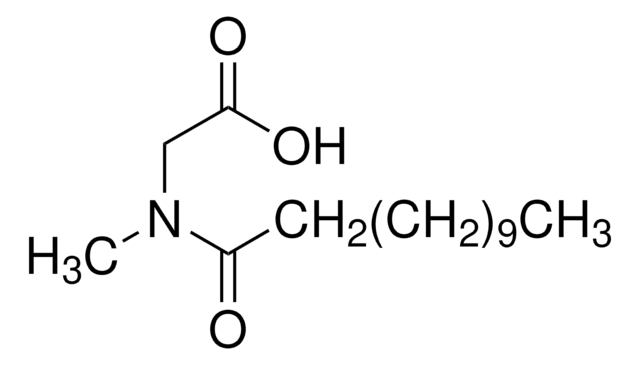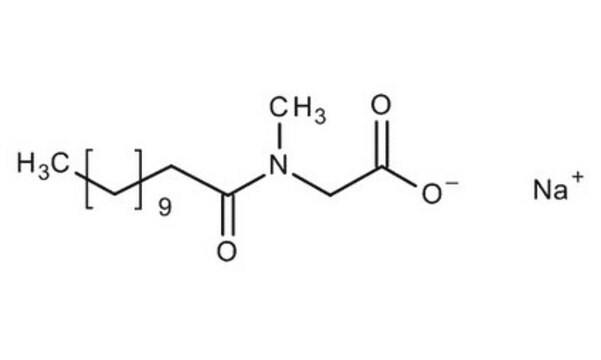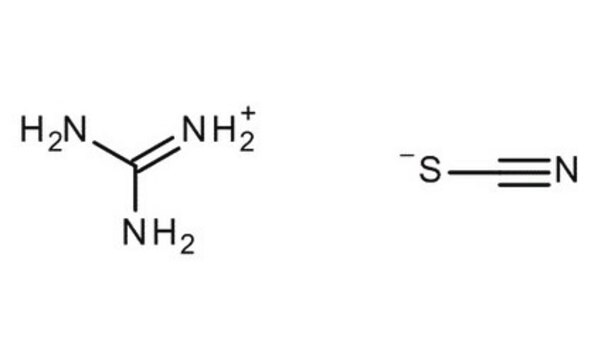L9150
N-Lauroylsarcosine sodium salt
detergent for use in cell lysis
Synonyme(s) :
Sodium lauroyl sarcosinate, N-Dodecanoyl-N-methylglycine sodium salt, Sarkosyl NL
About This Item
Produits recommandés
Qualité
for molecular biology
Niveau de qualité
Description
anionic
Gamme de produits
BioReagent
Essai
≥94%
Forme
powder
Poids mol.
micellar avg mol wt 600
Nombre d'agrégation
2
Technique(s)
protein purification: suitable
protein quantification: suitable
CMC
14.6 mM (20-25°C)
Solubilité
H2O: 100 mg/mL, clear to slightly hazy, colorless to faintly yellow
Activité étrangère
DNase, RNase, none detected
Température de stockage
room temp
Chaîne SMILES
[Na+].CCCCCCCCCCCC(=O)N(C)CC([O-])=O
InChI
1S/C15H29NO3.Na/c1-3-4-5-6-7-8-9-10-11-12-14(17)16(2)13-15(18)19;/h3-13H2,1-2H3,(H,18,19);/q;+1/p-1
Clé InChI
KSAVQLQVUXSOCR-UHFFFAOYSA-M
Vous recherchez des produits similaires ? Visite Guide de comparaison des produits
Catégories apparentées
Description générale
This amino acid-type anionic surfactant, also recognized as a fatty acid amide and detergent, exhibits protein denaturant potency and has been integrated into lysing solutions, such as the cornet assay. Its application extends to lysing protoplasts for chromosomal DNA isolation from Streptococcus mutans. Notably, Lauroylsarcosine Sodium Salt, characterized by its ionic detergent properties, is commonly employed for purifying membrane proteins. Additionally, Sodium Lauroyl Sarcosine also plays a crucial role in concentrated salt solutions, facilitating cell lysis in RNA purification protocols and membrane solubilization. Whether it′s breaking down cell structures or facilitating membrane protein purification, this mild surfactant proves valuable in various applications within the realms of biology and biochemistry.
Application
- solubilization and separation of membrane proteins
- lysis of cells during the isolation of RNA
- inhibition of hexokinase
Caractéristiques et avantages
- Suitable for Molecular Biology, Biochemical and Cell Biology research
- Can be used for Protein Purification and Quantification
- High purity product for research applications
Autres remarques
Produit comparable
Mention d'avertissement
Danger
Mentions de danger
Conseils de prudence
Classification des risques
Acute Tox. 2 Inhalation - Eye Dam. 1 - Skin Irrit. 2
Code de la classe de stockage
6.1A - Combustible, acute toxic Cat. 1 and 2 / very toxic hazardous materials
Classe de danger pour l'eau (WGK)
WGK 1
Point d'éclair (°F)
512.6 °F - closed cup
Point d'éclair (°C)
267 °C - closed cup
Équipement de protection individuelle
Eyeshields, Gloves, type N95 (US)
Faites votre choix parmi les versions les plus récentes :
Déjà en possession de ce produit ?
Retrouvez la documentation relative aux produits que vous avez récemment achetés dans la Bibliothèque de documents.
Les clients ont également consulté
Notre équipe de scientifiques dispose d'une expérience dans tous les secteurs de la recherche, notamment en sciences de la vie, science des matériaux, synthèse chimique, chromatographie, analyse et dans de nombreux autres domaines..
Contacter notre Service technique








